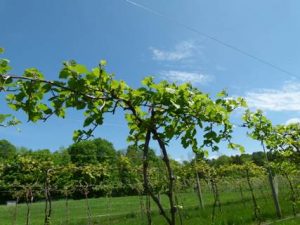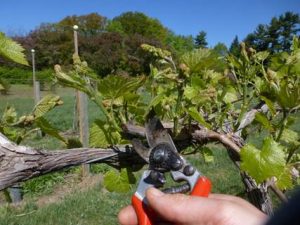Apologies if pictures don’t come through in this message, attached photos may be found in the corresponding blog post: http://blog.uvm.edu/fruit/2016/05/28/vineyard-management/
Grapes are moving fast in Vermont vineyards, with most cultivars in the UVM vineyard at about 3” shoot growth. Shoot thinning now will give best results before the vines waste energy on growth that you won’t keep. We typically aim for 4-6 well-spaced shoots per foot of canopy, selecting for the most healthy/vigorous and those with appropriate orientation for our downward training system (high-wire cordon).
Figure 1 Before shoot thinning
Figure 2 After shoot thinning
This is a typical time to start a spray program to manage disease. First, a warning- do not spray anything in the heat we are expecting today and tomorrow May 28-29. Application of many materials just prior to and most anything during heat over 85°F can cause phytotoxicity to vines. So have a nice Memorial Day, than get back to work Tuesday.
The primary disease of concern at this point is phomopsis, as rachis infection at this point in the season is may cause significant fruit loss at harvest. Anthracnose may also be active at this point , given the warm/hot weather. Most growers would do best to cover early this week with a contact fungicide like mancozeb or captan.
Organic growers are in for a bit more work. The standard fungicides, copper and sulfur, have only fair efficacy against this disease at best, and in a couple of weeks when black rot becomes the next disease of concern, those materials will have even less efficacy against that disease. The first line of defense in an organic vineyard is a strict sanitation program. This includes removing all mummies still in the canopy (not dropping on the ground, but actually removing them from the vineyard) as well as any obviously diseased wood. Phomopsis and anthracnose both overwinter largely on infected wood in the canopy, and removing this wood during dormant pruning or now is essential to reducing disease pressure. Stubs left at the ends of spurs should now be removed since you can see where this year’s shoot growth will resume (at the developing shoot)- these stubs will die and may become infected with phomopsis this season (or were last season) .
Figure 3 Removing stubs at end of retained spurs.
It is worth noting that both copper and sulfur (including lime sulfur) can cause phytotoxicity on certain cultivars. Dr. Patty McManus summarized her research on copper and sulfur sensitivity in cold-hardy grapes in the 2/8/16 Northern Grapes newsletter, and I’ll summarize it to say that Brianna should receive no copper; and Frontenac (all types), LaCrescent, Leon Millot, Marechal Foch, Marquette, and St. Croix should receive no more than 2-3 copper sprays per season. Save those for later when black rot and downy mildew become bigger concerns. Sulfur sensitivity was observed on several cultivars, and its use (including lime sulfur) is discouraged on Foch, Millot, Brianna, and Louise Swenson; with limited (2-3) applications suggested on LaCrescent and St. Croix.
So, if you have removed all diseased wood and are ready to cover your vineyard for protection against phomopsis and anthracnose, the best choices is likely lime sulfur applied at two quarts per acre in sufficient water (25-30 gallons should do it) to wet the canopy. Lime sulfur is hot stuff: caustic, corrosive, and noxious. Use appropriate personal protective equipment and spray in cooler weather to reduce phytotoxicity. Powdered sulfur may also be a good choice, I would suggest 3-5 pounds per acre at this stage.



